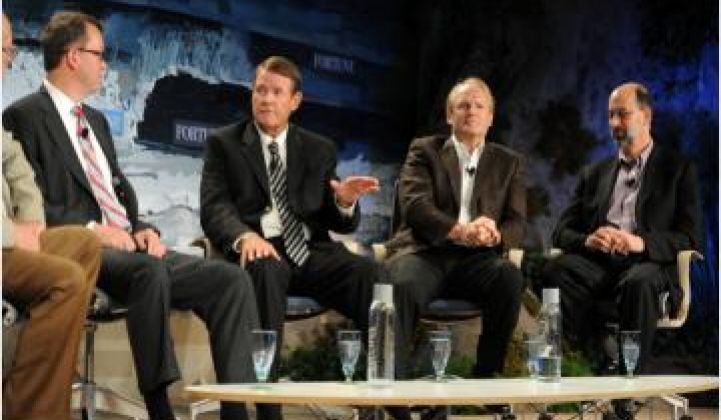Has Fukushima changed the nuclear debate? Let's just say it has pushed the two sides further apart.
“What we’ll do with this,” said Michael Morris, CEO of American Electric Power (AEP), of the Fukushima nuclear meltdown during a panel at Fortune Brainstorm Green this week, “is the same thing we did with Three Mile Island and the same thing we did with Chernobyl and really the same thing we did with 9/11. We’ll take the lessons learned and we’ll implement those best practices we can identify to see to it that we fortify beyond the designs that we’ve already got.”
AEP operates 38 gigawatts of power, including 2,200 megawatts of nuclear and 25 gigawatts of coal, as well as 255,000 miles of power lines for five million customers who get irate when they can’t find out who’s dancing with the stars.
New nuclear infrastructure will be built because power generation is, Morris said, “a states' rights issue. The state of Georgia has authorized Southern Company to build two stations. That’s going to happen.” Nuclear isn’t dead, he insisted. “There’s very little, other than the NRC, that the federal government has to do with nuclear power.”
As co-founder and CEO of VantagePoint Venture Partners, Alan Salzman manages over $5 billion in committed capital and oversees the world’s largest greentech investment team. He bristled at Morris’ remarks.
“If you can assure me that nuclear power stays within the state when there is an accident, Salzman retorted, “I’m much more willing to accede to the idea. I think the lessons of Japan and elsewhere tell you that it isn’t a localized, single state event.”
“Nuclear safety is regulated only by the federal government, not by the state government,” Morris replied. “The authority to go forward and invest the capital is a state issue.”
Morris also insisted that capital is available for the Georgia nuclear plants, with or without federal loan guarantees. Asked whether nuclear can compete with today’s remarkably cheap natural gas, Morris said the fuel cost is not what makes natural gas attractive.
“Capital cost for a combined cycle natural gas plant is $1,000 per kilowatt, capital cost for a coal plant is about $2,500 per kilowatt, capital cost for a nuclear plant is around $6,000 per kilowatt, capital cost for wind is about $2,500 per kilowatt, [and the] sun is about $8,000 per kilowatt.”
“That’s not true,” Salzman interrupted. “I don’t know where those numbers are from.”
“The people that I buy it from.”
“Somebody’s making a heck of a lot money, then,” Salzman said, and added, “I’m not here to talk about your individual profits. I thought you were regulated.”
After waiting out a laugh from the audience, Salzman went on. “Part of the problem in this discussion is getting accurate numbers. Finished plants come in nowhere near the prices you just quoted,” Salzman said, “and that was before the added safety aspects that are going to come up from Japan.”
With solar thermal, Salzman added, “you’re talking half those numbers.” And, Salzman said, the other important consideration is negawatts, or not having to replace capacity.
Dumaine looked at William Weihl, Google’s energy czar. “What’s your opinion? Google wants no coal.”
“We want no emissions,” Weihl said. “If we can do coal with CCS safely and cheaply and have it really work, that’s fine. The key is eliminating emissions. Nuclear is essentially zero emissions. Can we do it without nuclear? Probably, but I would hesitate to take it off the table.”
Either way, Weihl added, aggressive investments in R&D, innovation and deployment to create economies of scale are urgently needed.
Commissioner Philip Moeller of the U.S. Federal Energy Regulatory Commission (FERC) brought up the topic of transmission.
“If you build out the high voltage transmission grid,” Morris said, “you would have a huge economy of scale at moving electricity.”
That’s exactly what Google and its partners in the Atlantic Wind Connection transmission project are attempting to make happen, Weihl said, on behalf of offshore wind.
AEP’s newest high capacity transmission, Morris said, a 100-mile link, took over sixteen years to permit and build. For transmission, Morris said he recently told Senate Majority Leader Harry Reid (D-NV), “I need the authority that got 11,000 miles of gas pipelines built over the last decade and only 600 miles of high voltage transmission.”
“We have the authority to site gas pipelines. Or electric transmission,” Moeller said of FERC’s powers. “It’s states and localities.”
Asked if his call for federal authority over transmission contradicted his contention that power generation is a states' rights matter, Morris said, “The interstate transport of kilowatts across state lines is a federal issue.” A moment of unanimity on the panel ended when Morris added that, as the biggest coal burner in the U.S., he is certain coal will remain viable because it is abundant and inexpensive and that carbon capture and sequestration (CCS) will make it even more viable.
“There are lots of things that are plentiful and inexpensive,” Salzman responded, “that we’ve managed to get over, starting with child labor.”
The U.S. could migrate to natural gas over the next decade, Morris said, but the rest of the world will continue to build and burn coal and the technology will continue to advance.
“The last time I checked,” Salzman replied, “there was no Moore’s Law for coal.”



